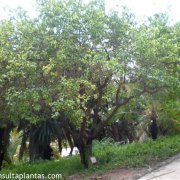Care of the shrub Poncirus trifoliata or Hardy orange |
|
The genus Poncirus, family Rutaceae, includes a single species of shrub native to Korea and China. Scientific synonyms: Citrus trifoliata, Bilacus trifoliata, Pseudaegle sepiaria, Aegle sepiaria. Common names: Trifoliate orange, Japanese bitter-orange, Hardy orange, Chinese bitter orange. They are shrubs or trees that reach 8 meters (26.24 ºF) in height. On the green and intertwined stems they have long spines up to 7 cm (2.75") in length. The glossy green leaves are scarce, leathery and are composed of 3 oval-shaped leaflets (the central one a little larger). The white, scented, 5-petal flowers sprout before the leaves. They bloom in early spring. The fruits, which give off a pleasant aroma, are like small oranges that are first green and then golden; they are not consumed since their taste is too sour. Hardy orange is used as isolated specimens, in groups of 2-3 specimens, to form impenetrable hedges and as rootstocks for other citrus fruits. Poncirus trifoliata needs full sun or semi-shade exposure. It resists the cold well. Japanese bitter-orange grows in any soil as long as it is well drained, even in poor soils. Planting will be done in spring or autumn. Water once a week in depth but do not flood; Chinese bitter orange does not withstand prolonged drought. Fertilize every 20 days in summer with mineral fertilizer. In autumn fertilize with manure. Prune intensively in winter if used as a hedge but will flower less. If Trifoliate orange is grown as isolated specimens it's better not to prune them. Poncirus trifoliata is a plant very resistant to pests and diseases. Hardy orange is propagated by cuttings in summer (under glass in a warm bed) or from seeds sown in spring. |
Images of the shrub Poncirus trifoliata or Hardy orange |
Find plants
Poncirus trifoliata or Hardy orange | Care and Growing
© 2025 FavThemes






